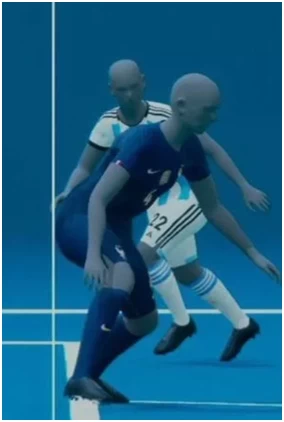
Arshveer Chhabra
The integration of technology in football began modestly, with FIFA or Fédération Internationale De Football Association -- the main governing body over international and club football --employing technology in the 2000s, mainly to resolve the issue of unfair officiating. One of the breakthrough technologies the sport witnessed was the goal line technology, post which began a new era of football and football officiating, ensuring greater accuracy and fairness in important matches.
As the sport embraced technological advancements, other innovations followed suit. Video Assistant Referee (VAR) technology emerged as a contentious yet transformative addition, allowing referees to review contended decisions with the aid of video footage. Despite initial scepticism, VAR has proven instrumental in minimizing human error and upholding the integrity of the game.
Current Technological Applications in Football:
A new revolutionary technology was introduced at the 2022 FIFA World Cup in Qatar, known as the semi-automated offside technology.
As per The FA, the governing body of association football in England:
“It is not an offence to be in an offside position.A player is in an offside position if:
* any part of the head, body or feet is in the opponents’ half (excluding the halfway line) and
* any part of the head, body or feet is nearer to the opponents’ goal line than both the ball and the second-last opponent
The hands and arms of all players, including the goalkeepers, are not considered. For the purposes of determining offside, the upper boundary of the arm is in line with the bottom of the armpit.

A player is not in an offside position if level with the:
second-last opponent or last two opponents”
While the Video Assistant Referee (VAR) has been available for some time, it took time to calculate if the player was offside, and the computer-drawn lines for offside based on the position of the player were subject to some error which is crucial as being even a millimetre off can have major consequencesfor the football match.
The Semi-Automated Offside Technology (SAOT) contains a sensor inside the football which is held using suspension technology. For the 2022 FIFA World Cup, Kinexon, a German company, designed an in-ball device which gives precise positional data and detects ball movement in a three-dimensional space. Every time the ball was hit, data was sent in real-time to several antennae around the pitch. The mind-boggling fact, however, is that data was sent at a rate of 500 frames per second.
Along with the in-ball device, 12 tracking cameras were paired up with AI in order to produce three-dimensional models of players for smoother and fairer officiating.
This SAOT was a major success in its application at the World Cup. During the finals between Argentina and France, it played a crucial role in the 18th minute of extra time when Lionel Messi scored the third goal for Argentina which put them in the lead. The goal was being checked by the officials for offside and the SOAT determined that Lautaro Martinez, the player who helped create the goal, was onside by a very fine margin.
However, in the contemporary landscape of football, technology extends far beyond officiating decisions. Infiltrating player performance analysis and training methodologies has boosted the level and quality of the players and the game. Player tracking systems, equipped with GPS and accelerometers, provide coaches with valuable insights into a player’s movement patterns, acceleration, and workload distribution during training sessions and matches.
Leading clubs also employ sophisticated data analytics platforms to interpret vast quantities of player performance data, facilitating evidence-based decision-making in team selection, tactics, and recruitment processes. This data-driven approach not only enhances tactical awareness but also optimizes player development providing a personalised player profile of strengths and weaknesses.
Furthermore, advancements in virtual reality (VR) and augmented reality (AR) technologies have revolutionized player training methodologies, offering simulation experiences that replicate match scenarios with a high level of realism. By integrating VR into training regimes, players can refine decision-making skills, spatial awareness, and tactical understanding in a risk-free environment, thereby accelerating their learning curve and improving on-field performance.
What The Future Holds:
Football technology is expected to advance further in the future, bringing with it even more innovation and improvement. Coaches will be able to find subtle patterns and predicted insights that are beyond human comprehension with the use of artificial intelligence (AI) and machine learning algorithms, which can completely transform tactical insights and match analysis.
Currently, in the nascent stage, wearable biometric sensors and smart fabrics offer a glimpse into the future of personalized athlete monitoring and injury prevention. By using real-time physiological data, coaches and sports scientists can reduce injury risks, optimize recovery, and help footballers not burn out and be forced to retire at a young age.
The integration of technology into football, therefore, represents a paradigm shift in the way the sport is played, analysed, and experienced. From its humble beginnings in goal-line technology to the cutting-edge innovations shaping the future of player performance analysis and training, technology has become a core part of the sport.
As we set out on this fascinating technical path, it is critical to keep in mind the moral and societal issues that come with its use. Football can create a collaborative atmosphere that values inclusivity, innovation, and integrity, and use the transformative potential of technology to inspire and empower generations of footballers, fans, and stakeholders worldwide.
Arshveer Chhabra is a first-year B.Tech student at Plaksha University, Mohali.




